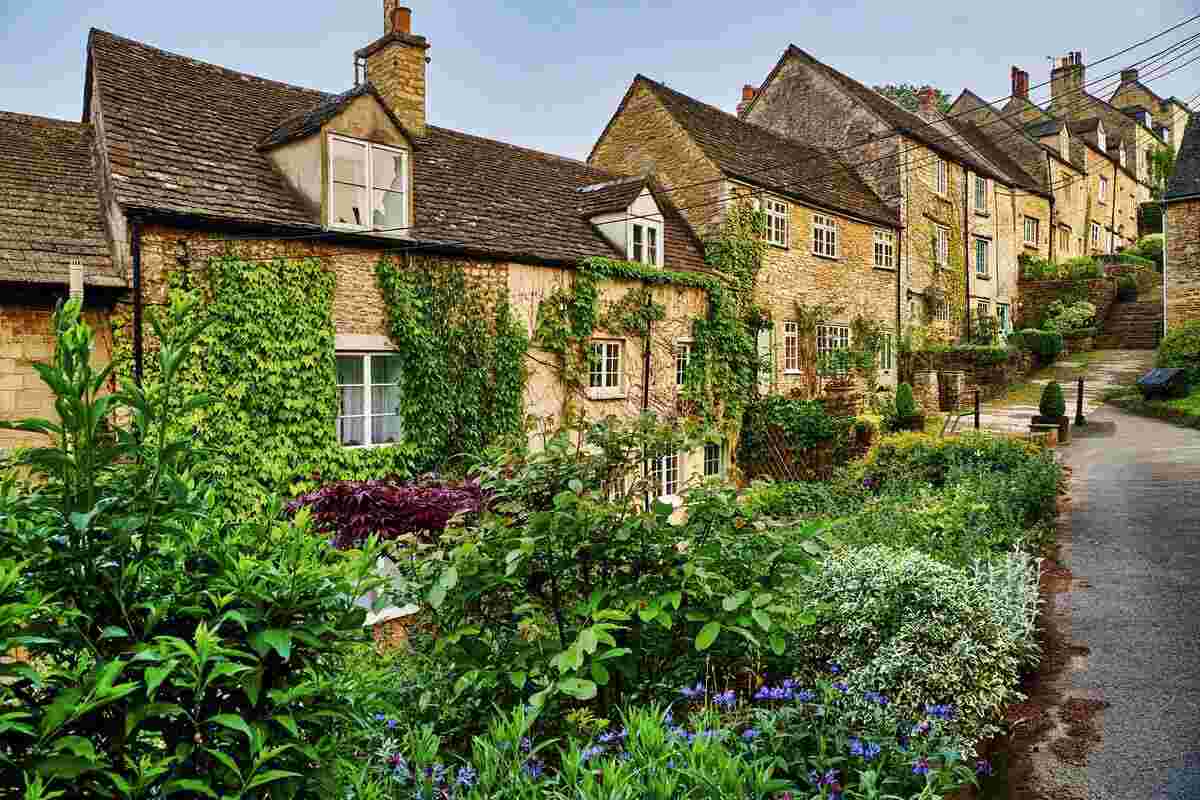The earliest English villages were formed about 900 AD when farms banded together for mutual protection and cooperation. Villages typically appeared next to rivers or large structures like churches or mills. Families switched from operating separate farms to cooperative farms. Many small English communities still exist today. Every village has a unique history that often dates centuries ago and is influenced by particular circumstances, even if they all share a common history. Let’s explore the 10 prettiest villages in England in detail.

Are you set to enter a postcard? Just wondering which locations have captivated travelers for ages? Come along as we explore some of the most lovely places in England! But hold on, first divulge. Are you craving for an escape encircled by breathtaking scenery and historical charm? You gave me a nod of affirmation. Let’s set out on this adventure.

Top 10 prettiest villages in the UK
1. Castle Combe, Wiltshire
Location:
Situated around 5 miles northwest of Chippenham, Castle Combe is hidden in the Cotswolds AONB of Wiltshire. It is divided into two sections: Upper Castle Combe, located to the east, and a historic neighborhood with no new homes since about 1600. To the south is the Castle Combe motor racing track.
History:
A Roman villa near Castle Combe was found about three miles from the settlement. Excavations there have revealed 4th-century bath houses and grain drying ovens, indicating ancient occupation. The name of the settlement comes from a neighboring castle from the 12th century mentioned in the Domesday Book of 1086.
The community flourished over the ages, becoming a center for the wool industry by the fifteenth century and possessing a market cross dating back to the fourteenth century. The village’s ownership changed multiple times over the centuries, with illustrious families like the Scropes and Gorsts making their mark. Changes brought on by modern projects include the 1998 closure of a historic school and the conversion of the old RAF airfield for motor racing, shaping the village’s contemporary landscape.
Religious sites
St. Andrew’s Church
Constructed during the 19th century, associated with a timeline tracing back to the remarkable era of the 13th century, St. Andrew’s Church stands as one of Castle Combe’s Grade I listed structures. Its well-known 15th-century tower, an undisputed testament to its enduring presence within the community over various centuries provides substantial evidence for its historical importance.
Congregational Church
The Congregational Church, founded in 1757, has changed over time. Its present edifice was inaugurated in 1914 and was formerly a quaint malt house. This historic site, tucked away in the hilltop village, serves the community with beauty and honor.
Travel services:
In addition to historical monuments like the Manor House, reconstructed in the 19th century and now a prominent hotel, Castle Combe offers visitors conveniences, including a parking lot and restrooms. The Manor House Hotel offers 21 rooms, a golf course, and beautiful gardens. It was once a New Zealand Forest Officers base during World War II.
2. Hope Cove, Devon
Location:
In Devon, England, Hope Cove is a quaint seaside community in the South Huish civil parish. Situated approximately 5 miles west of Kingsbridge and 5 miles west of Salcombe, it boasts two beaches and is shielded by the Bolt Tail cliff.
History:
Hope Cove, known from the Old Norse term for “bay” or “the entry,” was formerly divided into Inner Hope and Outer Hope, two areas popular for smugglers and hunting. The Spanish Armada sailed past in 1588; after that, there was an accident involving the San Pedro el Mayor. In addition to being a radar center and runway during World War II, the town was a source of motivation for Victorian painter Sir Luke Fildes. Additionally, it appeared in the 1980s British comedy film “The Supergrass.”
Sites to visit
Hope Cove LifeBoats
The Hope Cove lifeboat station was opened in 1878 and shut down in 1930. After being brought back in 1992 by the Maritime and Coastguard Agency, it gained community backing and was declared autonomous in 2010. Thanks to donations, the lifeboat was restored in 2013 and is currently manned and managed by volunteers.
Travel Services:
The village is located in the beautiful South Devon Area of Outstanding Natural Beauty and is mainly a tourist destination. With the premiere of BBC’s midday drama “The Coroner” in 2015, which was based at The House on the Beach, it became well-known. A second series of the show debuted in 2016. In addition, The Cove Café Bar gained honors as the UK’s top Independent Craft Beer Bar (rural) in 2018.
3. Kingham, Oxfordshire
Location:
Located in the Cotswolds, about 4 miles southwest of Rolling Norton, Oxfordshire, lies the settlement and legal parish of Kingham. 913 people were living in the parish as of the 2011 Data.
History:
Starting in 1845 and ending in 1853, the Oxford, Worcester, and Wolverhampton Railway ran through the west portion of Kingham. Connecting the OW&W with the Cotswold Norton Railway, Cotswold Norton Junction opened its doors in 1855. OW&W was acquired by Great Western Railway in 1862, and in 1909, the interchange station was renamed “Kingham.” A new building replaced the old railway station in Kingham after British Railways shut the branch lines to Chipping Norton and Bourton-on-the-Water in 1962.
Places to visit:
With later extensions and repairs, St. Andrew’s parish church has a Gothic tower from the 14th century and a top from the 15th century. The church’s eight ringing bells were cast in 1924.
Travel Services:
For both residents and visitors, Kingham, Oxfordshire Travel Services provides a variety of transit choices.
4. Fingest, Buckinghamshire
Location:
Fingest is located six miles southwest of High Wycombe in the Cotswold Hills of Buckinghamshire, close to the Oxfordshire border. Going back to the late Norman era, the Grade I listed St Bartholomew’s church features a distinctive tower style with a pair of domed roofs.
History:
Fingest’s property was once a part of St Albans Abbey, but in 1163, it was given to the Bishop of Lincoln before going private. The civil church of the village grew in 1934 by annexing land from nearby parishes, and then in the 1980s, it combined with Hambleden parish. In 2013, Fingest was used as the set for the motion picture “The Monuments Men.”
Places to visit:
Fingest is a charming village set among Georgian and medieval houses, with a magnificent parish church and the pub ‘The Chequers’ surrounding it. The church is distinguished by its unusual twin-gabled Norman tower and sticks out from the neighborhood’s typical flint or natural brick façade with its vibrant ochre finish. Hikers exploring the area’s quaint trails are drawn to Fingest, tucked away amid the picturesque Chiltern hills.
Travel Services:
In the heart of the village, you will find The Chequers Inn – a charming local bar brimming with warmth. Taking a leisurely ramble around the enchanting footpaths within the village offers tourists an opportunity to discover breathtaking landscapes encapsulating St. Bartholomew’s ancient church.
5. Bibury, Gloucestershire
Location:
Bibury is a much esteemed and welcoming township lodged in Gloucestershire’s distinguished zone of supreme natural splendor known for beautifying England’s Cotswolds region. The famous spot – Arlington Row cottages are a major point of attraction.
History
Bibury is infused with extensive Roman roots and preserves ancient remnants from the excellent Medieval wool trade. It’s situated amidst the picturesque surroundings of the Cotswolds, giving history buffs an enriching encounter paired with beautiful scenery. Of particular interest are structures like Arlington Row cottages, reminiscent of elegance and awe-inspiring architecture and bearing historical relevance since their construction in the 17th century as a prominent wool depot.
Places to visit:
Arlington Row cottages, along with the ancient St. Mary’s Church, contribute significantly to the irresistible allure of Bibury. To wrap up an exploratory tour through this endearing hamlet, unwind at its quaint tea room that offers a diversified palette of classic English meals, proving it’s not complete without this experience. While there, grow with tranquil walks along the scenic banks of River Coln.
Cotswold Wildlife Park and Gardens are also most attractive spots that allow immersive experiences amidst beautiful nature, well worth exploring further.
6. Polperro, Cornwall
Location:
Polperro, nestled in England’s southern region of Cornwall, is a delightful fishing village filled with narrow streets, an alluring harbor area and picturesque coastal landscapes full of amazement.
History:
Steeped in rich maritime tradition, Polperro has played a crucial part in smuggling operations throughout history. The town’s intricate lanes and hidden corridors reveal myriad tales emblematic of its notorious past involving unlawful trade.
Places to visit:
The Polperro Heritage Museum welcomes visitors intent on learning about this quaint Cornish village’s captivating maritime heritage. It sheds light on the epoch when seafaring habits were shrouded with smuggling activities rampant within the community.
7. Hutton-le-Hole, North Yorkshire
Location:
Tucked away in the North York Moors National Park, Hutton-le-Hole has a peaceful beck and a gorgeous location with old stone cottages. Discovering its conserved history at the Ryedale Folk Museum and taking in the natural splendor of the nearby moorland scenery are enjoyable activities for tourists.
History:
North Yorkshire’s Hutton-le-Hole has a long and colorful past that dates back several centuries. The historic structures and antiques housed in the Ryedale Folk Museum provide witness to the village’s prehistoric heritage. The village’s history is entwined with the North York Moors’ agricultural customs, providing tourists with an understanding of its cultural significance.
Places to visit:
Hutton-le-Hole, nestled in North Yorkshire, offers an invitation to all visitors. You will delve into the history embedded in Ryedale Folk Museum and enjoy peaceful walks through rows of antiquated stone homes and scenic watercourses. Located amidst the picturesque landscapes of North York Moors National Park, this quaint setting serves as a serene sanctuary, providing opportunities for engaging with nature’s gifts.
8. Hawkshead, Cumbria
Location:
Hawkshead, in the historic county of Lancashire, England’s Westmorland and Furness, comprises villages such as Hawkshead Hill and Outgate. It has four bars, one elementary school, and no high school. Situated in a valley west of Windermere and east of Coniston Water, Hawkshead is immediately north of Esthwaite Water.
History:
Initially owned by Furness Abbey, Hawkshead saw its first charter granted in 1608 and developed into a prominent wool market and eventually a market town. Linked to writers such as Wordsworth and Potter, it became a popular tourist destination after establishing Lake District National Park. However, it kept its rustic charm; it is now controlled mainly by the National Trust.
9. Rye, East Sussex
Location:
The historic town of Rye is located in East Sussex, England, near the Atlantic Ocean and about 10 miles from the English Channel.
History:
Rye, an English town nestled in East Sussex, has a long and rich history that dates back to the Middle Ages. Initially a thriving port town essential to the wool trade, it eventually prospered as a center for smuggling operations. Its strategically located beach and well-preserved medieval buildings encourage tourists to explore its charming alleyways and fascinating history.
Places to visit:
In Rye, East Sussex, tourists can gaze at the famous Ypres Tower, a medieval stronghold providing stunning panoramas, and stroll Mermaid Street’s cobblestone streets lined with antique timber-framed buildings.
The Rye Castle Museum explores the town’s marine and criminal history, while the Rye Harbour Nature Reserve entices nature lovers with its varied wildlife and picturesque trails. Furthermore, St. Mary’s Parish Church offers insight into Rye’s religious heritage with its remarkable beauty and ancient history.
Travel services:
There are several different ways to get around Rye, East Sussex, including buses, taxis, and a well-connected train station with connections to London. While eco-aware tourists can tour by bicycle along picturesque paths like Rye Harbour Nature Reserve, car rentals offer flexibility. Airport shuttles, boat excursions, and guided tours guarantee everyone a convenient and unforgettable experience.
10. Clovelly, Devon
Location:
John Rous of the Hamlyn family owns Clovelly, a charming harbor village in the Torridge area of Devon. Its historic architecture and cobblestone alleys, nestled along the cliffs of north Devon, draw tourists who pay an admission fee to explore various activities. According to the survey, the village’s population decreased somewhat in 2011 despite holding festivals like the Lobster and Crab Festival.
History:
With origins dating back to the Iron Age, Clovelly saw radical transformations under George Cary in the late 16th century, becoming a thriving center for fishing. Its strong links to three well-known families—notably, the Hamlyns since 1738—highlight its extensive history and ongoing conservation initiatives. The independently owned village nevertheless enchants tourists today with its historical value and charming scenery.
The Clovelly Lifeboat Station
An RNLI lifeboat station has operated out of Clovelly since 1870; the initial £175 boathouse was built for the station. The lifeboat rescued the lives of 158 people between 1899 and 1931. A lifeboat of the Atlantic 85-class called for Toby Rundle was added to the station when it reopened in 1998 following a brief shutdown in 1988.
Travel Services:
The Red Lion Hotel is a historic lodging option in Clovelly, Devon, and the well-kept Clovelly Court Gardens provide picturesque peace. Before savoring regional food at the New Inn bar, travelers can explore the village’s past at the Visitor Museum. Discover Clovelly Harbour, a fundamental aspect of this quaint beach town, without fail.
What is the most peaceful village in the UK?
Many people rank Castle Combe in Wiltshire among the most peaceful. Castle Combe is a serene haven for those looking for calm amid beautiful surroundings because of its serene atmosphere, well-preserved medieval design, and lack of large tourist crowds.
Which part of the UK is most beautiful?
England’s Cotswolds area, with its breathtaking vistas and charming rural landscapes, is one of the most picturesque locales in the United Kingdom. Amidst rolling hills, lazy rivers, and quaint villages featuring warm-toned stone cottages—it effortlessly captivates visitors with its timeless appeal.
Bountiful in natural beauty infused with an authentic English aura, The Cotswolds is a coveted destination for nature enthusiasts and travellers alike. Offering popular attractions such as Bibury’s famed Arlington Row and enduring medieval trading cities, like Stow-on-the-Wold—Contributing to some aspects of this region’s allure.
What is the most American-looking city in the UK?
Bath is frequently cited as the UK’s most American-looking city. Bath has a very American feel, with its Georgian architecture, broad roads, and roomy parks symbolic of places like Boston and Philadelphia. Its historical significance and abundant structures, such as the Circus and the Royal Crescent, also add to the city’s likeness to American cities from the same era.
Finally Prettiest Villages England in Short
These are the prettiest villages in England for a relaxing retreat between stunning landscapes and historical landmarks. Every village offers a unique experience, from the enthralling alleyways of Castle Combe to the classic charm of Bourton-on-the-Water. Indulge in delicious handcrafted treats at charming tearooms, walk around charming cobblestone alleys, and discover the intriguing history of England.
Are you ready to embark on an amazing trip across the rural areas of England? Plan your journey now and explore an exciting adventure, searching for undiscovered treasures.





